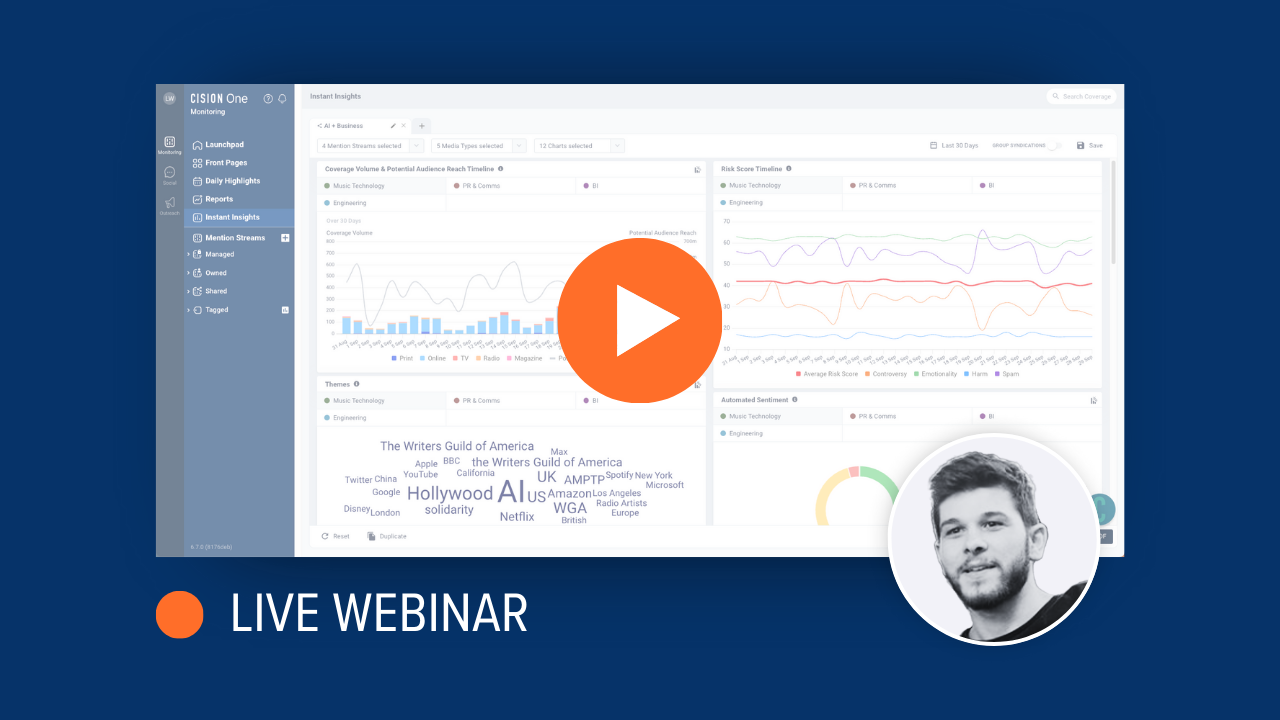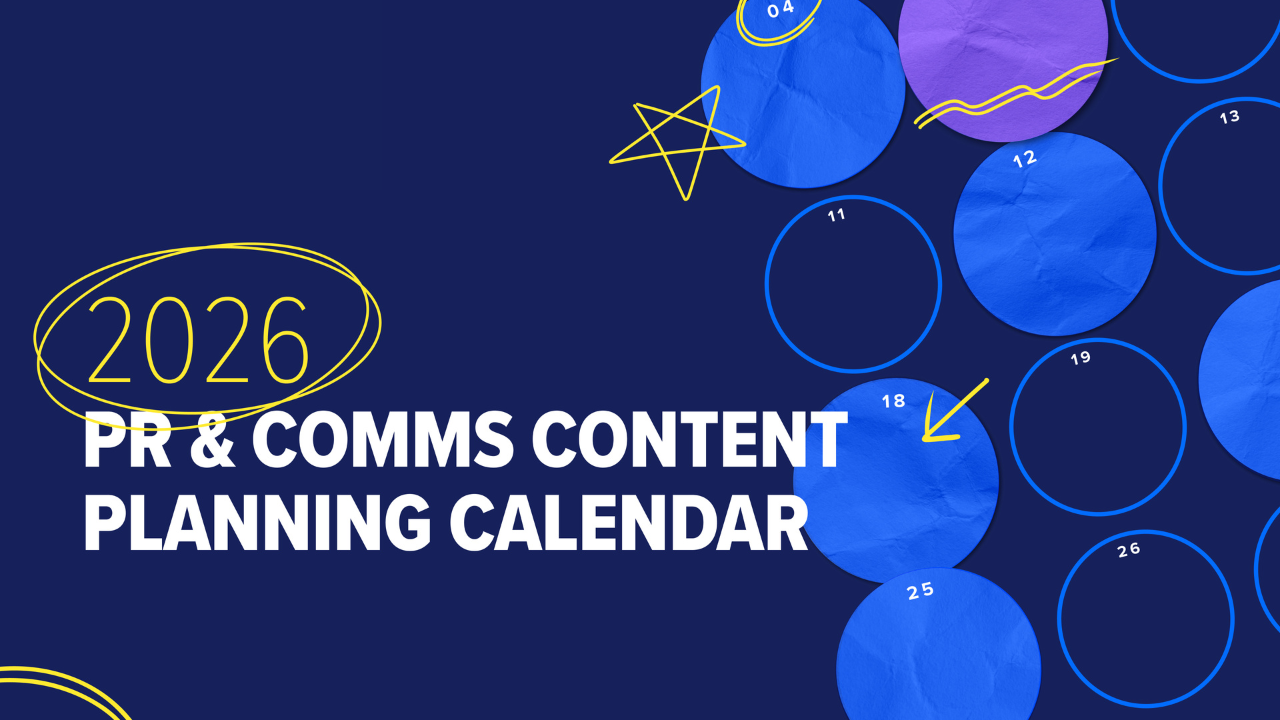One of the surest ways to improve your PR strategy is to measure your performance data to understand the results of your efforts. Unfortunately for many PR teams, measuring performance is easier said than done: According to the 2025 Comms Report, 37% of PR teams feel they are unable to measure impact effectively, and 43% struggle to turn data into actionable insights. These findings indicate that even as PR teams understand the importance of PR metrics and measurement, there’s a disconnect preventing them from applying them in a meaningful and effective way.
Understanding the various PR metrics and measurement tactics available as well as how to track and interpret them, is a critical first step to bridging that gap. From there you can identify which metrics matter most for your goals – and how to apply them effectively.
Why Is Measuring PR Effectiveness Important?
Measuring PR effectiveness is essential for understanding how well your campaigns, media outreach, and other activities are performing. Data reveals how many people see your content, how they talk about your brand, and how your outreach is landing.
Once you know how your PR efforts are performing, you can address any underperforming areas. This might mean changing how you address your audience if they aren’t engaging with your content as you expect or tailoring your approach to pitching to journalists if your outreach doesn’t result in quality coverage (or even responses).
PR metrics and measurements enable you to demonstrate the ROI of your team’s budget. Data that proves the effectiveness of your campaign, for example, can help justify requests for further resources from decision makers by showing what you have achieved and what may be possible with a bigger budget.
The PR Metrics and Measurement Methods You Need to Know
Digital tools have changed the way PR professionals work, especially when it comes to data collection and analysis. We can now track and report on a huge range of public relations metrics to understand how our efforts are performing.
But because there are so many PR metrics and measurement methods available, we’ve split the list into several sections covering metrics that are useful to PR pros even though the data is primarily used in other areas of marketing:
- PR metrics
- Web metrics
- SEO metrics
- Social media metrics
Public Relations Metrics
Public relations metrics are the most important pieces of data for PR pros to know about. They relate to the activities that make up most of the work you do for a brand.
Impressions
The total number of times a piece of content is displayed or potentially viewed (just because content is displayed doesn’t mean users see or notice it if they scroll past it too quickly, so it was shown but not in a meaningful way). Impressions cover instances where users see a piece of content multiple times.
Reach
The total number of unique individuals who have seen a piece of content, reflecting the size of your audience.
Engagement
The number of interactions with your content, such as clicks, form completions, or time spent on a page. Use engagement as an indicator of how useful or relevant people find your content.
Sentiment
Mentions of a brand and the underlying feelings behind them. Sentiment helps you identify how audiences feel about your brand or products, whether positive, negative, or neutral.
Return On Investment (ROI)
Measures the monetary value generated from a PR activity against the amount of time spent on that activity. ROI shows how cost-effective your efforts are.
Advertising Value Equivalency (AVE)
The comparison of PR coverage against the cost of paying for the same coverage placement. AVE is used to place a cost value to earned media coverage, which helps with budgeting. Though it has a reputation as a “vanity metric,” AVE can still offer value in certain contexts.
Earned Media Mentions
Mentions of your brand in unpaid media sources, such as print and digital articles, interviews, social posts, and reviews. Earned media mentions indicate your team’s ability to generate media coverage organically.
Coverage by Media Type
How much coverage your brand earns by media type, such as print, broadcast, online, and social media, enabling you to see where you predominantly gain coverage and areas to focus on.
Brand Mentions
The number of times a brand is mentioned across media and digital platforms. Brand mentions are useful in understanding how often people speak about your brand and products or services.
Share of Voice (SOV)
The percentage of coverage a business receives compared to competitors. SOV is a good indicator of where your brand stands next to the competition.
Pitch Open Rate
How often journalists open the pitches you send. Pitch open rate is an indicator of whether the pitches you send grab a journalist’s attention, so you can modify your approach to improve results.
Pitch Response Rate
How often journalists respond to your pitches. Pitch response rates can show whether your content is relevant or interesting to the journalists you’re contacting. Use this metric to refine your content ideas and journalist targeting.
Web Metrics
Web metrics are important for PR professionals to be aware of, as they reveal how much traffic comes to your brand’s website from various sources, including press releases, earned media, and PR campaigns.
Sessions
The traffic coming to and using a website from any source. Sessions count each visit to a website, including repeat visits from the same user, and you can filter the source to see where traffic comes from (search engines, paid ads, other websites, etc.).
Users
The number of individuals visiting your website. One user can return to the website multiple times to generate multiple sessions. Tracking New Users shows the number of unique visitors to your website (which is useful to see how your audience is growing).
Engagement Time
The time users spend actively moving and engaging with an individual web page, including page elements such as multimedia, forms fills or link clicks. Engagement time can indicate how useful users find your page.
Conversions
Actions users take on your website, such as product purchases, service sign-ups, form completions, or content downloads.
Conversion Rate
The percentage of total visitors who take a desired action (conversion). Conversion rate shows how much of your traffic is relevant and engaged with your website and brand.
Bounce Rate
The percentage of users who leave a website after viewing only one page. Bounce rate can be tricky to interpret because it can indicate that a webpage isn’t relevant to users needs, or it can be a sign that users found their answer without needing to explore further.
Exit Rate
The number of people that leave your website from a specific webpage. A high exist rate could suggest the natural end of a user’s journey (such as a “thank you” page), or it could signal that the content isn’t relevant or engaging enough to keep users exploring.
SEO Metrics
Search engine optimization (SEO) metrics focus primarily on organic traffic to a website from search engines, such as Google or Bing; however, PR professionals can influence organic traffic numbers through certain activities, such as earning media coverage.
Keywords
Words and phrases that help content rank in search engine results. Inserting relevant keywords naturally into content helps search engines connect the content with a user’s search query. The more high-ranking keywords you have, the more likely users will find your content.
Domain Authority
The authority score of a website. Domain authority can predict how likely a website is to rank in search engine results, with higher scores having a greater chance of reaching the highest positions.
Backlinks
The number of links pointing to your website from a different website. Backlinks show search engines that your content is valuable and trustworthy, helping boost domain authority. Backlinks help users navigate between relevant websites.
Social Media Metrics
Social media metrics reveal how people interact with content on the platforms they spend so much time on. You can learn a lot about how people engage with your content and what their interests are.
Impressions
The total number of times a piece of content is viewed. Impressions don’t indicate whether a user engages with the content, and the content can be displayed to users more than once.
Reach
The total number of unique users who see a piece of content. Even if the same user views it multiple times, they are only counted once. Reach helps show the actual size of your audience.
Engagement
The number of interactions with a piece of content, such as likes, shares, comments, or replies. The more engagements a piece of content gets, the more relevant and valued it is by users.
Video Views
The number of times users watch a video on social media. Each platform calculates this metric differently, often requiring a minimum view time, so the exact count can vary depending on where the video is published.
Click-Through-Rate (CTR)
The percentage of users who click a link within a piece of content. The link may take them to another page, website, or app. A high CTR indicates the content is relevant and drives user action.
How Do You Choose the Right Public Relations Metrics to Track?
While there are many public relations metrics available to track, you don’t need to track every single one, as long as you’re tracking the right ones for your goals. Here’s a breakdown of how different metrics align to some of the most common PR goals:
If your goal is brand awareness, focus on metrics such as:
- Reach
- Impressions
- Engagement
If your goal is reputation management, focus on metrics like:
- Media mentions
- Sentiment analysis
- Share of voice
If your goal is lead generation, focus on metrics including:
- Total leads
- Lead quality
- Conversions
- Conversion rate
If your goal is increasing traffic to your website, focus on:
- Sessions
- Referral traffic
- Conversions
- Conversion rate
Let your goals inform which metrics you track. Aligning goals with specific metrics will make reporting more focused and actionable.
To find out more about PR metrics and how to use them effectively, check out our Complete Guide to PR Measurement.
A Note on Qualitative Metrics
Most of the metrics listed above are quantitative data (numerical data that you can count or measure) that is easy to track, measure, and act on, but qualitative data (non-numerical information) is harder to track in a tangible sense, but just as important to understand the “why” behind a user’s actions.
When analyzed together, qualitative and quantitative data can give you a more robust picture of performance.
The Tools for Measuring PR Metrics and Measurement
Now that you know what public relations metrics are out there, you should know how to track them.
There’s no single platform that tracks and measures every available metric, but once you determine the most valuable data to track you can choose the best tools for your needs. Some of your options include:
- CisionOne - Tracks PR and social media metrics, such as media mentions, sentiment, and engagement, and helps teams turn that data into actionable insights to improve their PR efforts and strategies
- Google Analytics – Tracks website traffic, traffic sources, page engagement, and key events/conversions (such as sales, form completions etc)
- Google Search Console - Track how your website performs in Google search results through impressions, clicks, click-through rates, and average position for your webpages
- Ahrefs - Tracks website traffic, backlinks, and keyword rankings
- SEMrush – Tracks keyword rankings, website traffic, and backlinks
- Social media insights – Most platforms have insights to track impressions, reach, and engagement
You’ll find that some tools collect a range of data collated from multiple sources, making it easier to track the data you need with fewer tools. Using fewer tools can make data collection easier, but you might notice discrepancies with the data in tools collating the information from multiple sources compared to using the native source. You will have to balance the convenience of fewer tools with the discrepancies they can bring versus using multiple tools with native data.
Improve Your Strategy by Measuring PR Results
Using the right PR metrics and measurement tactics will help you improve your PR strategy by identifying where you can make changes. The list of metrics above include data used by other marketing teams and disciplines, such as SEO and social media, but are still useful in measuring success and finding areas to improve.
To get the most out of your PR efforts, regardless of the data or who else uses it, follow these steps:
- Understand the public relations metrics that matter
- Choose the best metrics to track for your unique goals
- Use the right tools to track your chosen metrics
- Analyze the data and adjust your plan accordingly
The most important step in the above list is the second: choosing the best metrics to track. Think about the goals you’re working toward, as well as the wider business goals you contribute to, and identify the metrics that relate to those goals. With those metrics identified, you can better identify the right tools to track them and optimize for maximum effect.
Organize a demo with one of our experts to see how you can use CisionOne for measuring PR results and improving your strategy.
Most Recent Posts
Cision Resources
-
E-books and Guides
Comprehensive how-to guides on strategy and tactics
-
Case Studies
What are other brands doing – and how can we learn from them?
About Dave McCreery
Dave is the Senior Content Manager at Cision specializing in SEO-driven content strategies. He has over 10 years of content creation experience and proven success crafting stories that engage, educate, and entertain audiences across different markets and industries.
Learn More. Do More. demo new
PR Tips, Case Studies, and Product Updates

[On-Demand Webinar] The Next Generation of Media Intelligence: From Gorkana to CisionOne
Explore CisionOne, a revolutionary media intelligence platform, and the evolution of Gorkana. Learn key features and strategies from Luke Williams, CisionOne Product Marketing Manager. Elevate your media outreach to new heights!


